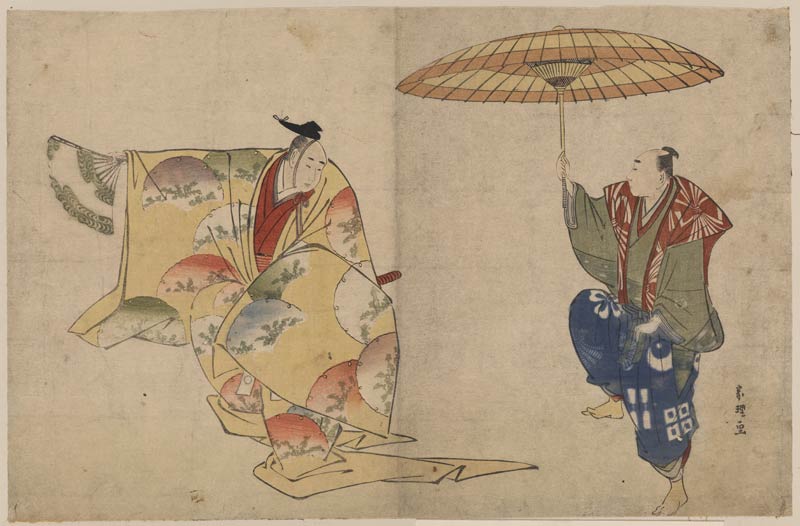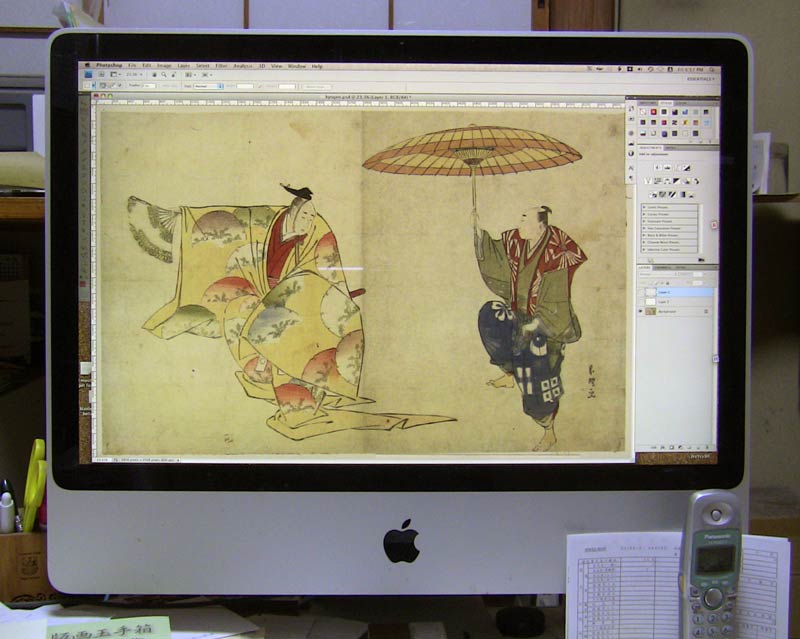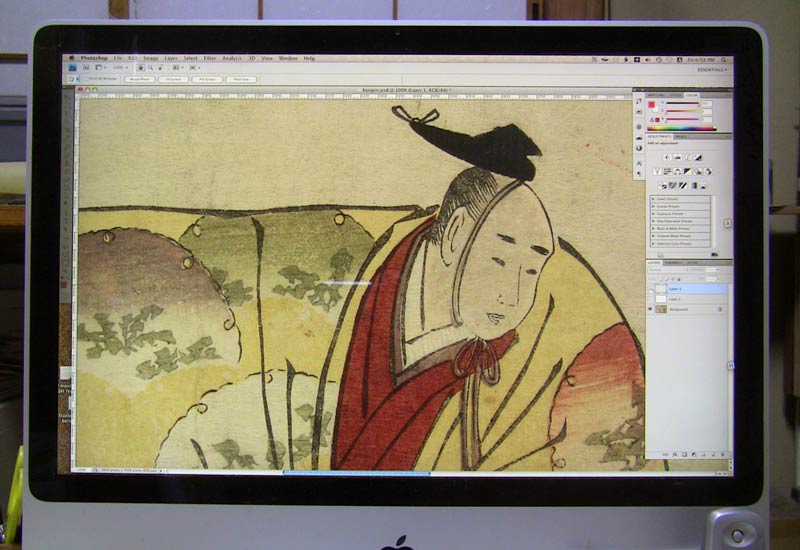Today's postings
- [Baren 45175] Re: Pasting a large sheet of paper on the woodblock (Cucamongie # aol.com)
- [Baren 45176] Welcome, Mary Brodbeck! (Lawrence H Pinto)
- [Baren 45177] Mary's Introduction and Tibi's Paper Pasting (Annie Bissett)
- [Baren 45178] Mary (Guadalupe Victorica)
- [Baren 45179] Pasting a large sheet of paper on the woodblock (Tibi Chelcea) (Lee Churchill)
- [Baren 45180] Re: please let me introduce myself (Louise Cass)
- [Baren 45181] RE: Pasting a large sheet of paper on the woodblock (Tibi Chelcea) ("Maria Arango Diener")
- [Baren 45182] Mary's work ("Megan Lloyd-Thompson")
- [Baren 45183] dragon gallery (Carole Baker)
- [Baren 45184] Baren Member blogs: Update Notification (Blog Manager)

Message 1
From: Cucamongie # aol.com
Date: Thu, 01 Mar 2012 13:51:44 GMT
Subject: [Baren 45175] Re: Pasting a large sheet of paper on the woodblock
Send Message: To this poster
use the most efficient way, but I found that putting my drawing on tracing
paper (including kento marks if you use a kento), flipping over the paper,
tape it down to the block w/carbon paper underneath, then drawing over
the traced lines was what worked well for me. very low-tech and a bit
time-consuming depending on complexity of your drawing but it definitely works.
Sarah Hauser
cucamongie@aol.com
_http://sarahhauser.neoimages.net_ (http://sarahhauser.neoimages.net/)
(art site)
_http://healingenergyforanimals.com_ (http://healingenergyforanimals.com/)
(site re work with animals)

Message 2
From: Lawrence H Pinto
Date: Thu, 01 Mar 2012 14:12:11 GMT
Subject: [Baren 45176] Welcome, Mary Brodbeck!
Send Message: To this poster
Welcome, Mary!
Larry

Message 3
From: Annie Bissett
Date: Thu, 01 Mar 2012 14:15:30 GMT
Subject: [Baren 45177] Mary's Introduction and Tibi's Paper Pasting
Send Message: To this poster
Tibi, I've found that large paper is really difficult to glue it down on the board without bubbles, wrinkles and stretching. I agree with Barbara that rice paste is a better choice because it's not as wet as the acrylic/water mixture you tried. Mike Lyon once wrote that after you brush on the rice paste you can pat it with your hand to raise little "peaks." The peaks will grab the paper, yet not so tightly that you can't reposition it before you press down more to adhere it. I usually begin the final adhering at the center and work outward. Also, it's best to pat the paper down rather than rub it. The paper will begin to stretch and wrinkle right away as it comes into contact with the moisture from the paste, so rubbing it will just encourage it to stretch unevenly.
Actually, my first teacher Matt Brown taught me to lightly dampen the sketch first. This makes sense, as then the paper doesn't warp and stretch from coming in contact with the moisture of the paste. The problem with dampening it first is that the size of the sketch changes when it's wet (larger) so if you're applying the sketch to multiple blocks you can have registration problems if some are wetter than others.
As I've been working very large lately, I've been using other methods to get my design on the block since the problems with pasting a sketch overwhelm me! I often trace the design using transfer/carbon paper or just draw on the block. I've also been adjusting my designs so they aren't so registration-sensitive.
Good luck!
best to all,
Annie

Message 4
From: Guadalupe Victorica
Date: Thu, 01 Mar 2012 14:55:11 GMT
Subject: [Baren 45178] Mary
Send Message: To this poster
Mary I like your work very much, congratullations.
saludos from Mexico, Guadalupe

Message 5
From: Lee Churchill
Date: Thu, 01 Mar 2012 15:52:10 GMT
Subject: [Baren 45179] Pasting a large sheet of paper on the woodblock (Tibi Chelcea)
Send Message: To this poster
One, I agree with the question of why acrylic? It doesn’t have a long open time, even watered down, and when you try to wash it off the block to print you’ll get little rolls of rubbery crud (if it comes off at all). Any paste adhesive would be better.
Second, did you put the acrylic on the block or the paper? If you glued the block your paper would be absorbing moisture and expanding while you tried to stick it down, not a good scenario and would lead to tons of bubbles.
If there’s some reason you ‘have’ to use acrylic you might try this procedure, though this works well for paste too:
1) Put your copy on a sheet of Mylar drafting vellum or other non water absorbing base, like polyethylene sheet (aka painters plastic sheeting) spritz it on both sides with a fine water sprayer. Cover it with another sheet of plastic and let it sit for ‘awhile’ to be sure it’s expanded evenly. (If when you come back it’s cockled and seems dry in some areas, spritz again, you want it to be very lightly damp and not wet at all)
2) Then brush the acrylic on, then wait a minute to make absolutely sure the paper has expand FULLY, with copy papers you might see some rippling – gently brush these out until your sheet stays flat.
3) Depending on the size of the block and how long you think it will take you to do the next step (how dry your climate is, yada yada), you might want to _lightly_ spritz or brush the block with water as well – it will keep the wood from sucking the moisture out of your glue so if you need to reposition you have a better shot at it.
4) Using the plastic sheet as a carrier (this is where Mylar is better because it’s stiffer) turn the copy over onto the block, line it up, and starting at the centre and working outwards, rub it down with a brayer, bone folder or something else hard, until you’ve covered the whole surface. (I start at centre in hopes that any wrinkles that might form from rubbing will be outside the main design area, others may have different thoughts…I’m not sure there’s a right or wrong as long as it works)
5) Take the Mylar/plastic off and let dry overnight. It’s always a good idea to dry on an edge rather than flat, different woods can cup during drying, even plywood if it’s thin.
If you still get bubbles there’s something you can try – I can’t guarantee it will work because it depends on a lot of variables, like the type of acrylic paint (they all have different melting points) and the thickness of the polymer layer (if it’s too watered there just may not be enough ‘stick’), but you can sometimes iron the bubbles down. First you have to slit the paper on the bubble (otherwise the air has nowhere to go!), then carefully run an iron over the area, working towards the slits so you’re forcing the air out. You will likely have to play with the temperature and pressure. I wouldn’t use an iron that you want to use for your good clothes…if you have a small craft iron it’s ideal.
Another possibility is using a fine syringe to inject glue into the spaces, then rubbing them down. It can be time consuming but depending, it might be worth it. The problem is that you will normally get little ‘jets’ of excess adhesive coming back out of the hole, and even if you wipe it off, it makes rubbing the paper off later harder…
Other people will hopefully have more insight about rubbing oil on the block – I’ve never done it I’ve always peeled and rubbed the fibres off – but it seems like, especially with the acrylic layer, it’s adding another layer of something that won’t print well with a water-based adhesive? One of the reasons to use paste is that it will wash right off the block so you have a clean printing surface.
Hope this helps,
Lee
Lee Oldford Churchill
Ladybug Paper Studio
6, 2132-35 Ave SW
Calgary, AB
T2T 2E3
ph:403-685-1208
email: ladybugpaper@shaw.ca

Message 6
From: Louise Cass
Date: Thu, 01 Mar 2012 16:29:53 GMT
Subject: [Baren 45180] Re: please let me introduce myself
Send Message: To this poster
you've joined the Baren Forum.
bwLouise Cass
www.LCassArt.com

Message 7
From: "Maria Arango Diener"
Date: Thu, 01 Mar 2012 16:51:16 GMT
Subject: [Baren 45181] RE: Pasting a large sheet of paper on the woodblock (Tibi Chelcea)
Send Message: To this poster
Although I usually purchase mine from the Barenmall or McClain’s I have successfully made my own and it’s very easy. Just paste the two papers together and weigh down until well dry. I use glassine (waxy paper) between each sheet to prevent sticking.
Once you have your hanshita or in your case the copy paper, I have had very good luck with this alternative and perhaps easier method with sheets as large as 22” x 30”:
-Lightly dampen the copy to be pasted until just soft to the touch, I dampen and let sit for about an hour between blotters. This expands the paper but I have also done my method dry and nothing horrible happens.
-Spread rice paste on the block, I use fairly dry mixture of Blick paste for this (right out of the tube). I spread with a foam roller used for painting edges and trim. You can spread the paste very quickly and evenly with a foam roller.
-Paste down the copy and smooth lightly with either a dry rubber roller or a soft touch of the hand (your hand :-). Don’t spend a lot of time on this step because the next step will smooth out the paper.
-Place a non-stick cover on the paper like glassine, plastic or whatever and then quickly weigh down the whole block. I found best to place the entire block on my press and weigh down with a board but placing a board over your block and using weights works well too.
-Wait patiently and in about a couple of hours the copy will be stuck, shrunk, no bubbles, no gaps. The secret is to get an even layer of fairly dry rice paste and not mess with it very much once it is smoothed on and weigh it down quickly.
Good luck, much to try!
Maria
[=o=][=o=][=o=][=o=]
www.1000woodcuts.com
www.artfestivalguide.info
[=o=][=o=][=o=][=o=]

Message 8
From: "Megan Lloyd-Thompson"
Date: Thu, 01 Mar 2012 16:57:09 GMT
Subject: [Baren 45182] Mary's work
Send Message: To this poster

Message 9
From: Carole Baker
Date: Thu, 01 Mar 2012 16:58:07 GMT
Subject: [Baren 45183] dragon gallery
Send Message: To this poster
the gallery since Feb 12. I won't be home for another few weeks. If
you've sent your prints and yours didn't make it to me before I left
home, you could email me a scan and I can add it.
Terry, I can grab yours (a very clever one, indeed) off your blog if
OK with you.
The gallery is here: http://barenforum.org/new_year/dragon2012/
dragonsgallery2012.html
Carole Baker
bogorchid@gmail.com
Digest Appendix
Postings made on [Baren] members' blogs
over the past 24 hours ...
Subject: Arts of Japan series : first actual work ...
Posted by: Dave Bull
|
After endless 'playing around' over at the workshops of the giant Mokuhankan Corporation, trying to get the new knife series up and running, it's time to 'get real', and get some actual productive printmaking work done. If my own subscription prints don't start moving out the door again pretty soon, none of the other projects will be able to survive ... Our subject for this first print in the set is an image created by the man we now know as Hokusai, although he was using the handle 'Sori' when he drew this one. It dates from around 1798, and is the only illustrated page in what has been described as "an otherwise featureless book of quite unmemorable verse."  The process starts with getting the image into my iMac, and then opening it in Photoshop.  I scanned it at quite a high resolution, so even at 100% (before any other enlargement), I can see all the detail I need:  |
This item is taken from the blog Woodblock RoundTable.
'Reply' to Baren about this item.
Subject: Getting down to duck-ness
Posted by: Sherrie Y
|
Okay, okay... I guess it's time to prove that I've been working away on a new reduction linocut. More waterfowl? Hmmm. I seem to be in a watery rut at the moment. As a reminder, here was the first pass. Two colors, ink applied through a stencil to keep the color where I wanted it.
I carved a bit and then used the same stencil to apply the next two colors. You already know what species these are, doncha?
A little more carving and then... you guessed it... I used the same stencil to apply the next three colors. I did, however, remove a tiny bit more of the stencil material (mylar) to accommodate the female duck's foot.
This item is taken from the blog Brush and Baren. Subject: City blocks from big cities and small cities New York and Kansas
This item is taken from the blog MCPP Puzzle Prints. |



